The Westside Barbell Method, also known as the “Conjugate Method”, was developed by Louie Simmons. Westside Barbell, the gym, has produced more multiply world record holders than any other single gym in the history of powerlifting. To this day, the Westside Barbell Book of Methods is one of the most interesting works I’ve ever read on powerlifting – albeit also one of the more incoherent and contradictory works as well.
As you might expect, on the back of such success, the Westside Method grew increasingly popular during the rise of the multiply movement. There was a period in powerlifting where the vast majority of Americans were either using Westside or attempting to do so. Things have changed. Westside has fallen out of favor among the raw powerlifting movement that dominates the scene today. We’re going to take a look at why.
If you’d rather watch than read:
Westside: Background, History, Context
Speaking about the origins and development of Westside is extremely difficult because there is a lot of conflicting information out there. However, what is clear is that the original Westside Barbell gym was based out of Culver City, California. This group of men first popularized the box squat. The Culver City gym had a tremendous impact on Louie Simmons’ training philosophy and thinking. As such, Louie named his gym Westside Barbell in their honor.
The methods employed at Louie’s Westside Barbell were developed both organically and through the extrapolation of principles from old Eastern bloc sports science literature. To this day, Westside is essentially a giant laboratory for Louie Simmons to test various ideas upon his athletes. In this manner, parts of the system developed evolutionarily based on what was working and what wasn’t.
On the other hand, the Westside system is primarily modeled from three original sources: Russian weightlifting methods, Bulgarian weightlifting methods, and A.S. Prilepin’s work on the optimal sets and reps for developing strength in the Olympic weightlifter.
Essentially, Louie is a tremendous believer in the specificity of the Bulgarian system. For those unfamiliar, Bulgaria, despite being a small, economically depressed country, developed more weightlifting medalists than any other single country during the height of their dominance. Legendary coach Abadjiev had his lifters use only a handful of exercises: the back squat, the front squat, the clean, the jerk, and the snatch. The lifters would often work up to a max on these movements multiple times per day. In other words, they basically did nothing BUT their sport to improve for their sport. This weekly maxing is called the “Max Effort Method”.
In an ironic twist, Louie combined this ideology with that of the Russian weightlifting Dynamo Club which used a veritable stable of special exercises. The club often featured up to 45 different exercises and many of the lifters, supposedly, claimed they wanted even more variations to choose from. At Westside, Louie kept the idea of regular maxing, but also incorporated the massive stable of special exercises. Simmons went far beyond 45 exercises; Westside uses HUNDREDS, if not THOUSANDS, of movement variations.
Citing both the high burnout rate of the Bulgarian system, and the differences in training for weightlifting versus powerlifting, Louie discarded the idea that maxing should occur every single session. As such, he combined his odd mixture of the Russian and Bulgarian systems with work done by A.S. Prilepin. Prilepin, through a study of hundreds of weightlifters, found ideal combinations of sets and reps that best facilitated bar speed, technical development, and strength in the Olympic lifter.
Here’s the table:
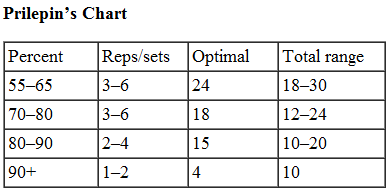
As you can see, the chart prescribes sets and reps for the optimal training effect in various intensity zones.
Using Prilepin’s work, the “Dynamic Effort” method was born. One day per week, the lower body is trained to a max and on another the upperbody day is trained to a max. However, on the other two days in Westside programming, you do “speed work” using Prilepin’s chart. Generally, this involves singles, doubles, and triples at 50-60% of your one rep max. This lighter loading theoretically allows for better recovery after the “max effort” sessions while still making the lifter stronger because maximal bar speed and technique are maintained and improved.
In simple terms, you recover and get faster on the “Dynamic Effort” days and you wear out your “CNS” on the “Maximal Effort” days.
As you can see, the construction of Westside was anything but simple. The ideas are based on the works of a variety of different sports scientists. The rest of this article is going to explain why I feel this odd mish-mash of principles has been applied incorrectly to the sport of powerlifting.
Westside: The Program
First of all, it is critically important to note that there is no “official” Westside program. A simple structure is provided and nothing more. No two people run Westside the same way. The program is intended to be highly individualized and customized. This makes it very difficult to actually review, but we’re going to focus here on the principles rather than the specifics to make it work.
Here’s the general template that floats around the internet:

During the week, you have a dynamic effort method day and a maximal method effort day for both the upper and lowerbody. The program is thus a four times per week, upper/lower split.
The dynamic effort bench days involve you using ~50-60% of your raw max for 6-8 sets of three. The dynamic effort lowerbody days involve you using 40-60% of your raw max for 10-12 sets of two on the box squat. Some versions also call for 6-10 sets of 1 rep on the deadlift using 60-85% of your max. Bands and chains are used to accommodate resistance and prevent you from slowing down near the top of the rep. Speed is supposed to be your guide here. You should be able to move the weight as fast as you can move the empty bar, but only when you apply your hardest effort.
The dynamic effort work is periodized in three week waves. That is, you start at 50% for one week, you go to 55% the next week, and then you finish with 60% on the third week. For the fourth week, you repeat the cycle.
Here’s an example of me performing “DE” work back when I tried Westside:
On the max effort days, you work up to a max single any variation of the bench press, squat, deadlift, or good morning on the respective upperbody and lowerbody days in the program. You should use a different variation every single week (sometimes the book says every two weeks). The goal is to work up to 90%+. Generally, the protocol involves taking one rep at 90% of your PR, attempting to break your PR by a small margin on the next rep, and then taking perhaps one more rep if you feel you have an additional bigger PR. In this manner, each max effort day is generally 2-3 reps at 90%+.
You’ll notice that both days incorporate a ton of assistance and bodybuilding work. This is called the “repetition method”.
Westside often uses up to 10 “extra” general physical preparation (GPP) workouts per week. These workouts often include sled pulling, reverse hyper, bodybuilding accessories, GHR, dumbbell work for time, jumps, and virtually anything you can think of that might aid in improving overall GPP and work capacity.
Planning
Because Westside is a program developed explicitly for powerlifting, there are clear and concise plans for meet peaking. Namely, Westside uses a “circamax” phase.
The circamax phase begins six weeks out from the meet and replaces the usual dynamic effort method days.
Let’s look at the squat as an example. Using 50% band tension, the lifter spends three weeks doing doubles between 90-97%. This is incredibly taxing and difficult, but prepares the lifter for the upcoming meet. The final three weeks are spent deloading and peaking.
It is important to note that max effort day work is often substituted for rep work, sled pulling, and other less intensive means during the circamax phase. In the last week, meet week, after the circamax workout, only short, simple workouts to enhance blood flow are performed. These workouts would include things such as reverse-hypers, glute ham raises, and abs.
Periodization
Louie’s original motivation for developing Westside came out of the fact that he was frustrated with traditional western periodization. For those unfamiliar, traditional western periodization usually involves spending 2-3 weeks working up to a set of 10, then another 2-3 weeks working up to a set of 8, then another 2-3 weeks working up to a set of 5, and so and so forth down to singles for a meet peak. In other words, hypertrophy and strength are developed sequentially along the intensity continuum. This is essentially block periodization.
Louie recognized that emphasizing hypertrophy for so long wasn’t optimal for strength development. He also chaffed against the idea that all of these qualities should be developed at separate times. So, in Westside, you have full days dedicated to certain qualities. You have dynamic effort day which is dedicated to speed and max effort day which is dedicated to strength. On both days, high reps are used on assistance movements to further hypertrophy.
Louie calls this “conjugate periodization” because all the qualities are trained simultaneously. However, as we’ve previously learned, when you attempt to improve all qualities in one mesocycle, this is actually called concurrent periodization. Western periodization, ironically, was developed as a response to the ineffectiveness of concurrent periodization for advanced athletes! In terms of periodization, Louie had actually gone back a step, added some new twists, and completely renamed something that already existed.
Westside, in terms of periodization, is periodized most appropriately for the early intermediate trainee. Why? Because the program features a weekly mesocycle just like, say, the Texas Method. Even though you’re manipulating intensity from week to week on the speed work, the volume is held, more or less, constant so you’re really not varying programming significantly from week to week.
Now, exercise selection is varied greatly on Westside, but this is not the same thing as programmatic variation in intensity and volume. Just because you do a different exercise each week doesn’t mean you’re introducing a new element of periodization.
Westside and Drugs
Westside has a reputation as being a program that only works for lifters on drugs. In my opinion, the structure of the program is the root of this criticism. Let’s take a closer look.
Why do advanced athletes need periods of emphasis on one quality or another? Because they only have so much recovery ability and as you become more advanced, you need more and more work to improve a quality. If you tried to improve all qualities simultaneously, the amount of work it would require would outstrip your ability to recover. So, in essence, certain qualities are improved separately or sequentially while others are maintained in order to prevent overtraining.
Here’s where drugs come in. What is the best way to drastically boost your overall recovery capabilities? Performance enhancing drugs! Rather than relying on more complex periodization models to make progress, rather than even manipulating volume from week to week, you can take drugs and simply recover from more overall work. This allows one to use concurrent periodization for MUCH longer than the average trainee will be able to. With drugs, the genetically gifted can use an early intermediate style of programimg right up to the very highest levels of powerlifting – it happens all the time! And Westside further enhances their lifters’ abilities to make use of concurrent periodization by doing countless GPP workouts to improve work capacity and thus their overall ability to recover. In my opinion, this is not sustainable for the natural athlete as they progress into later stages of training advancement.
Despite Westside’s reputation as a cutting edge system that can only be applied to the most advanced athletes profitably, the reality is that the program, just in terms of periodization, is actually best suited for early intermediate trainees who don’t need variation in volume or intensity from week to week.
Programming
Again, Westside does not feature significant variation in volume or intensity from week to week. You max out on the max effort day every single week. You hold the volume constant on dynamic effort day by reducing your sets as the intensity goes up. You’re doing, more or less, the same volume every week.
However, Westside DOES feature significant variation in terms of volume and intensity from session to session. Let’s do the basic math here using squats as an example. Say you’re doing 12 sets of 2 reps at 50% which for you is 200lbs. Your total volume is 12 * 2 * 200 = 4,800lbs. On max effort day, you might do the following: 365×1, 405×1, 410×1 for a total volume of 1,180lbs. As you can see, the dynamic effort day is up to four times as much volume as the max effort day.
That said, dynamic effort day also uses far less intensity. You’re using 50-60% of your max plus whatever the tension is on the particular bands that you’re using for speed work. Max effort day, every single week, should include intensity over 90% for 2-3 reps. In a lot of ways, this contrast is very similar to the Texas Method. And, in fact, in Practical Programming, Mark Rippetoe offers suggestions for how to transition the Texas Method into a Westside template as one becomes more advanced.
Specificity
Although Westside was designed explicitly for powerlifting, the main criticisms that I’m going to levy against the program all have to do with specificity.
First, let’s start with some of the principles of the program:
1) Only free squatting at meets and solely using the box squat in training
How can one possibly expect to technically master their raw squat form without practicing the movement? This is nonsensical and non-specific. Most raw lifters just completely ignore this aspect of Westside.
2) Only pause benching at meets
Again, during speed work and other max effort work, the Westside Barbell Book of Methods repeatedly admonishes pausing in training. Louie claims that the stretch reflex does not dissipate for 2 seconds and maintains even longer in trained athletes. The reality is pause bench pressing is a skill that needs to be practiced. If you’re constantly using touch and go bench presses, you’re training is not as specific as it could be to the competition version of the movement. Thus, your carryover will be decreased.
3) Not deadlifting in training
Westside is one of the more popular systems that advocate not deadlifting to improve the deadlift. I’m sure you can guess what I’m going to say about that. While managing fatigue properly is critical to improving any lift, you’re not doing yourself any favors by completely removing specificity from the equation. Instead of avoiding deadlifts altogether, it would be more intelligent to address the flaws in your fatigue management structure so that deadlifts can continue to be trained. Remember, if you want to pull more, you have to pull more. Nothing carries over better to the deadlift than actually improving your deadlift. Crazy concept, right?
4) The “Conjugate” Method of Max Effort Exercise Selection
The idea behind using a different exercise every max effort day is that you will avoid the law of accommodation. Louie repeatedly claims that spending more than 3 weeks in a row at 90%+ on the same exercise will result in diminished performance due to CNS fatigue. While it is true that you’ll avoid accommodation issues by rotating the exercises every single week, you’ll also avoid maximal adaptation due to a lack of specificity! No matter how intelligently you pick your exercises, NOTHING has a higher % of carryover to the competition movements than making actual improvements on the competition movements. You don’t HAVE to go to 90%+ every week, either!
5) The usefulness of the “Dynamic Effort” Method
Look, in powerlifting, it doesn’t matter how fast you complete a rep so long as you complete the rep. Louie repeatedly claims you only have a certain amount of time to finish a maximal attempt. This is true. You have about ten seconds before you maximally deplete ATP stores and maximal force production is no longer possible. How many times have you seen a lifter miss because they were grinding for 10 seconds?
Let’s say that you have seen this. What good will improving our speed do? Let’s think about it. For the strength athlete, in terms of rate of force development (RFD), it might take 0.3-0.4 seconds to reach maximal rates of force. Let’s say you generated a 100% improvement in RFD. This would be a substantial lifetime achievement that most athletes never accomplish. You would now have earned yourself another 0.2 seconds to grind out that weight.
Let’s ask another question. How many times have you seen a lifter grinding for ten seconds, fail the lift, and then, afterwards, you thought to yourself, “Man, if he only had another 0.2-0.3 seconds he would’ve gotten it for sure”! I’ve never seen it.
Some people claim that you can generate maximal force production with sub-maximal weights on the bar. While you can certainly learn to exert more force on sub-maximal weights, force production is not maximized until heavy weights are put on the bar. Tendo unit experiments done by Mike Tuchscherer confirm this. Speed work does NOT allow you to use maximal force production with sub-maximal weights!
Speed work is not specific to powerlifting because it does not directly translate to improved performance for all the reasons discussed here. As such, it makes virtually no sense to feature speed work as one of the most prominent parts of a powerlifting program.
6) Emphasis on Bands and Chains for Raw Lifters
The primary purpose of bands and chains are to provide accommodating resistance. Here’s the thing. Different parts of any lift are going to be easier than others. That is, leverage changes throughout the range of motion. During any lift there is going to be a “sticking point” (Louie calls these mini-maxes). This is the area where your force production is the least and it is generally your point of worst mechanical leverage. With bands and chains, you can still load a weight that is hard to break through your sticking point while simultaneously training the rest of the range of motion harder as well. This is because bands and chains make the lift more difficult at the top.
There’s only one issue with this line of thinking in raw lifting. Most raw lifters have sticking points at the bottom of the movement! Unlike geared lifters who generally get the most help from their suits and shirts right at the bottom, and thus need that extra top end range of motion work badly, most raw lifters actually need more bottom end work to address their strength curve deficiencies in order that they may continue to make progress. Bands and chains only serve to alter their form (less so with chains) and decrease overall specificity to their training.
Now, I’m absolutely not saying that bands and chains have no place whatsoever in the training of a raw lifter, but I do think it is crazy to do the absolute majority of your work using these tools. You don’t need as much overload at the top as a raw lifter. It just doesn’t need to be a primary focus.
Overall, Westside, in my opinion, is simply not specific enough to raw powerlifting. Personally, I would never recommend Westside to the raw lifter.
Overload
Westside employs a form of progressive overload. As you set new maxes, the weights you use for dynamic effort increase. As you get stronger, the weights you go for on max effort method day also should increase. In other words, you overload via handling heavier weights over time.
Fatigue Management
The fatigue management system on Westside is actually brutally simple. There is nothing going on from week to week. The way that fatigue is managed is by employing an upper/lower split and making sure that you have appropriate volume and intensity variation from workout to workout.
In fact, I think Westside’s fatigue management is absolutely ideal for the early intermediate trainee. Similar to the Texas Method, Westside employs a high volume, low-medium intensity day and a low volume, high intensity day. For most early intermediate trainees, this is a great way to ensure they can continue to make weekly progress without failing to recover at the end of the week.
To top it all off, Westside employs an upper/lower split organization which further enhances recovery. You’re only training the upperbody and lowerbody twice per week respectively.
For advanced athletes, which is what Westside is really marketed to a lot of the time, I don’t think this is appropriate. Advanced athletes need more complicated periodization models and they certainly need SOME variation in volume and intensity from week to week. Advanced athletes cannot expect to make weekly progress. Advanced athletes cannot expect to improve all physical attributes simultaneously. Advanced athletes should not run cookie cutter versions of Westside.
Individual Differences
Westside covers nearly all the bases in terms of individual differences. Lifters are given latitude to choose the movements that they believe will carryover best to their competitive lifts. Lifters are allowed to work up to whatever weights they’re capable of on max effort days. Lifters are encouraged to base their speed work weights on how fast the bar is moving. Lifters even determine their overall volume, to some extent, through their choices on the assistance movements.
In simple terms, Westside autoregulates training intensity during every single training session. In my opinion, this is necessary and ideal for optimal progress in intermediate athletes.
However, Westside does not employ autoregulation of volume on the main movements. Max effort day is always between 3-5 lifts at 90%. This affords a certain degree of autoregulation in terms of volume, but the narrow range of reps allowed doesn’t amount to much in the end. Speed day volume is not autoregulated at all.
As I’ve said countless times throughout the programming series, everyone needs different volumes for optimal progress. Even the same person will occasionally need different volume from week to week. If they don’t sleep enough, they’ll need less volume. If they overeat, they may be able to handle more. If their girlfriend breaks up with them, they’ll need WAY less volume. If they have the best day ever, they’ll probably handle more volume. You need to account for these individual differences for optimal results. Without regulation of training volume, this isn’t possible.
Final Thoughts
I think the Westside Barbell Book of Methods is a fascinating read. While the “book” is really just a mish-mash of different articles Louie has written over the years, I guarantee you’ll be exposed to all kinds of new ideas about training that you’ve never heard before.
Here’s the problem, though; most of these ideas aren’t highly relevant to increasing raw powerlifting performance. Westside, while heavy on the science, misapplies a variety of different training methods to powerlifting.
Westside remains me of Frankenstein. The very best parts are borrowed haphazardly from various Eastern bloc systems and, put together, they actually just become a giant monster rather than a coherent, optimal system of training.
Look, Westside just isn’t specific enough to raw powerlifting. What raw powerlifter can succeed on a program that, literally, doesn’t use the free squat? What raw powerlifter can achieve optimal deadlift results without deadlifting? What raw powerlifter can build the biggest paused bench possible without ever training the paused bench? What raw powerlifter can perfect their technique when they’re constantly using bands and chains which tend to change the biomechanics of the lifts? What raw powerlifter is going to maximize strength gains by never doing work in the 80-90% range? What raw powerlifter is going to benefit maximally from “getting faster” in a sport that has no meaningful speed component?
As I said to begin this review, I cannot comment on what they do over at the real Westside Barbell. For all I know, the Westside Barbell Book of Methods is wholly unrepresentative of the training Louie’s guys actually do. That said, where else is the average powerlifter going to get their Westside info if not from the official book published on the subject?
Yes, I’m aware that you’re allowed to make endless modifications to Westside and the program is intended to be individualized and optimized. I can’t comment on every single variation of Westside out there. In this review, we’re focusing on the general principles presented in the Westside Barbell Book of Methods. If you have changed things up, that’s YOUR version of Westside and it isn’t what I’m addressing in this review.
Overall, the generic version of Westside that floats around the internet is not a great choice for the raw powerlifter in my opinion. Will you get stronger? Of course. Westside still does most things right. However, the real question is whether you will you get stronger at an optimal rate. For the reasons I’ve already argued, my answer to that question would be a resounding no. There are better options for the raw powerlifter than using the Westside and/or Conjugate System of training.
Did You Enjoy The ProgrammingToWin Series?
If so, you’ll absolutely love our eBook ProgrammingToWin! The book contains over 100 pages of content, discusses each scientific principle of programming in-depth, and provides six different full programs for novice and intermediate lifters. Get your copy now!
Moving Forward
Next up on our list of programs to review is one that I think has been highly anticipated: Sheiko’s numbered programs. We’ll focus on #29-#32 as those four cycles were actually written and intended to be used as a 16 week cycle. Many people don’t know that. We’ll talk about this issue and more in the next installment of the Powerlifting Programming series.
Like this Article? Subscribe to our Newsletter!
If you liked this articled, and you want instant updates whenever we put out new content, including exclusive subscriber articles and videos, sign up to our Newsletter!
Questions? Comments?
For all business and personal coaching services related inqueries, please contact me:
Table of Contents
Powerlifting Programs I: Scientific Principles of Powerlifting Programming
Powerlifting Programs II: Critical Training Variables
Powerlifting Programs III: Training Organization
Powerlifting Programs IV: Starting Strength
Powerlifting Programs V: StrongLifts 5×5
Powerlifting Programs VI: Jason Blaha’s 5×5 Novice Routine
Powerlifting Programs VII: Jonnie Candito’s Linear Program
Powerlifting Programs VIII: Sheiko’s Novice Routine
Powerlifting Programs IX: GreySkull Linear Progression
Powerlifting Programs X: The PowerliftingToWin Novice Program
Powerlifting Programs XI: Madcow’s 5×5
Powerlifting Programs XII: The Texas Method
Powerlifting Programs XIII: 5/3/1 and Beyond 5/3/1
Powerlifting Programs XIV: The Cube Method
Powerlifting Programs XV: The Juggernaut Method
Powerlifting Programs XVI: Westside Barbell Method
Powerlifting Programs XVII: Sheiko Routines
Powerlifting Programs XVIII: Smolov and Smolov Junior
Powerlifting Programs XIX: Paul Carter’s Base Building
Powerlifting Programs XX: The Lilliebridge Method
Powerlifting Programs XXI: Jonnie Candito’s 6 Week Strength Program
Powerlifting Programs XXII: The Bulgarian Method for Powerlifting
Powerlifting Programs XXIII: Brian Carroll’s 10/20/Life
Powerlifting Programs XXIV: Destroy the Opposition by Jamie Lewis
Powerlifting Programs XXV: The Coan/Philippi Deadlift Routine
Powerlifting Programs XXVI: Korte’s 3×3
Powerlifting Programs XXVII: RTS Generalized Intermediate Program
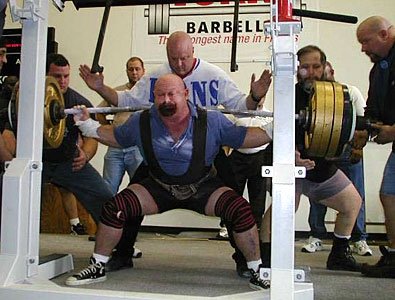
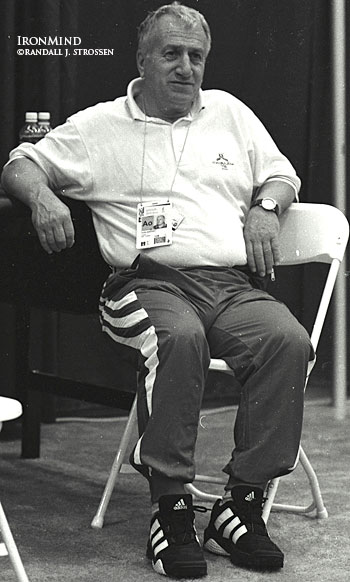
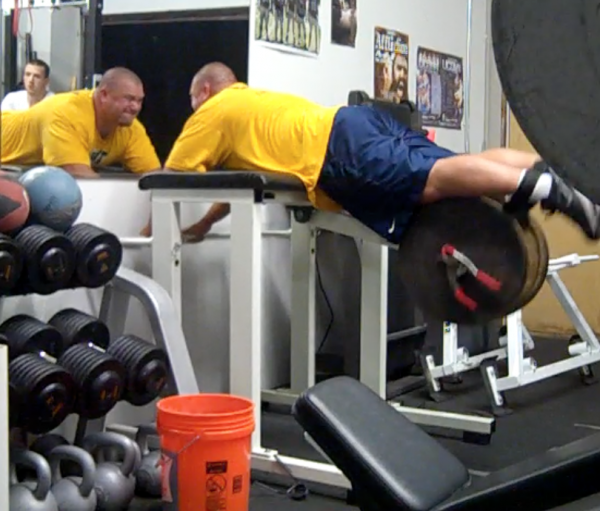
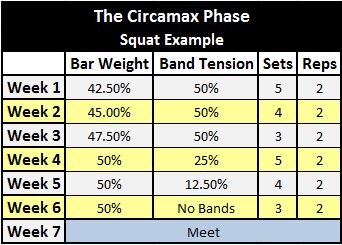

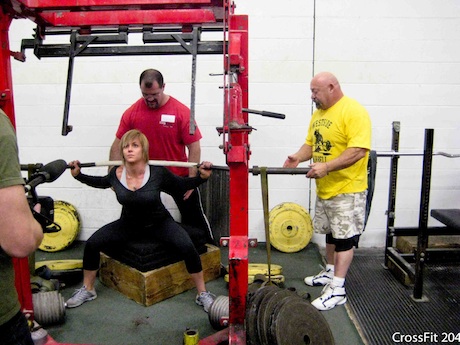
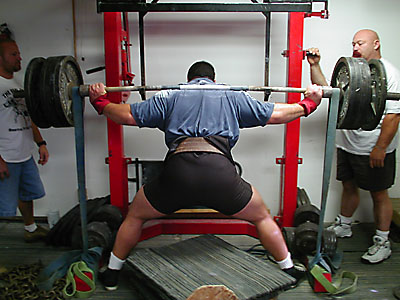

Great article! Totally agree that westside is for geared (implying equipment AND juicing) lifters
PS you’ve got a typo here:
” Westside remains (reminds) me of Frankenstein. “
Decent, but somewhat superficial synopsis of Westside. There are number of things I could contend but the biggest issue here for me is the critique of speed work. Your argument, I believe, is kind of missing the boat – speed in a lift is not about the last .2 seconds of a lift, it is about the 1st .2 seconds (e.g. deadlifts). It is also maximizing the stretch reflex.
Is your comment in the context of competitive powerlifting or are you making reference to general strength training? For powerlifting specific purposes, box squats are going to diminish the stretch reflex. For competition purposes, the bench is paused. Westside features TnG bench speed work and box squats, which, ironically, greatly decrease specificity even in terms of the stretch reflex. For competition purposes, I don’t think it matters, whatsoever, how fast you reach fMax. It just matters what the value of fMax is once you reach it. For other sports, okay, the arguments become different, but this is PowerliftingToWin.com.
I believe it does matter how rapidly you reach your fMax, e.g. you’d want to reach it before the least efficient portion of any lever aka sticking points. If you cannot reach fMax before say the mid shin point on a max deadlift you can get stuck; if you are at your fMax you will whip through that portion of the lift…
I agree with some of your contentions on training specificity; I would only argue that most of what you decry is not “Westside”… Box squats are used many reasons, and some of them are related to gear – but the box squat itself is just a tool that Westside CAN use, you can still “do Westside” w/o using box squats etc… you even allude to this in your review in that there is no “official” program, only a base template.
Perhaps that’s a fair way to look at it, but I would have to point out that if you cannot trust what the Westside Barbell Book of Method says is Westside then no one is really qualified to say what “Westside” is.
Dynamic Effort, Max Effort, and Repeated Effort (https://www.youtube.com/watch?v=vBB1GO_e5iY) – those are what I would see as the pillars of westside. Dynamic effort is likely to include things accommodating resistance, Max effort emphasizes conjugation etc. – those elements also form the core of westside… box squats are just a technique/method applied, in context, to some of the above principles…
Okay, that’s fine. Those are your definitions, but in the Westside Book of Methods Louie literally says there is never any reason to do paused benching, that they never do anything but box squats even for raw lifters, and that you shouldn’t pull frequently from the floor. Of course, Louie contradicts himself all over the place so it is impossible to critique Westside in the first place because it isn’t coherent. This is why I specifically went out of my way to say how difficult it is to critique Westside because everyone has their own opinions about what it actually is. Regardless, for reasons elucidated, I don’t find dynamic effort work particularly useful and I think the “conjugated” method of “max effort” is just non-specific in general.
Great article and video! One thing to point out is that on me day you must work up to a TRAINING Max. This provides the missing volume you spoke of. An 8×3 me work up for example provides more than enough volume before adding singles. You don’t work to a meet pr you work to a training day pr which is then attempted to be beat when that me specific variation comes back around if it does or during that particular wave.